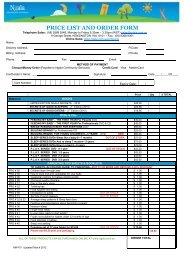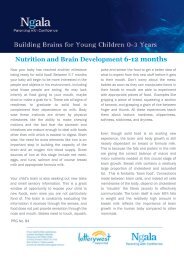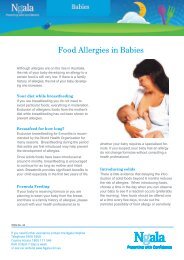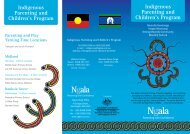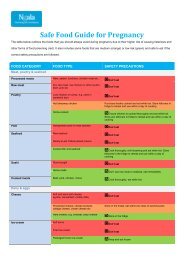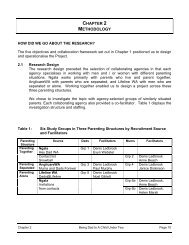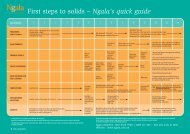Managing children's behaviour â Free of food additives! - Ngala
Managing children's behaviour â Free of food additives! - Ngala
Managing children's behaviour â Free of food additives! - Ngala
You also want an ePaper? Increase the reach of your titles
YUMPU automatically turns print PDFs into web optimized ePapers that Google loves.
FOOD ADDITIVES<br />
BY STEPHANIE FAIRBAIRN<br />
AND KIM JOHNSTONE,<br />
NGALA EDUCATION TEAM<br />
Beware the <strong>additives</strong><br />
<strong>Managing</strong> children’s <strong>behaviour</strong> – <strong>Free</strong> <strong>of</strong> <strong>food</strong> <strong>additives</strong>!<br />
Been to a kid’s birthday<br />
party recently? No<br />
doubt it was a lively<br />
affair, especially if the<br />
<strong>food</strong> served was <strong>of</strong><br />
the highly coloured,<br />
sweet variety. Maybe<br />
on the way home<br />
little Johnny had<br />
a post party<br />
crash and bed<br />
time was a<br />
drama?<br />
Most <strong>of</strong> us have suspected for<br />
a long time that ‘party’ <strong>food</strong> –<br />
the colours, fizzy drinks and<br />
sweet concoctions <strong>of</strong> ice cream cake,<br />
jelly, lollies and cheese-flavoured puffs<br />
were not conducive to calmness. Most<br />
children will react with a mixture <strong>of</strong><br />
loss <strong>of</strong> control, mood swings, difficulty<br />
getting to sleep and the dreaded<br />
tantrum. There is a growing body <strong>of</strong><br />
research linking ‘deterioration’ in<br />
<strong>behaviour</strong> and certain <strong>additives</strong> found<br />
in a variety <strong>of</strong> <strong>food</strong>s – mostly marketed<br />
to target children.<br />
A study published in the The Lancet<br />
medical journal in 2007 by the University<br />
<strong>of</strong> Southampton demonstrated a clear<br />
association between three common<br />
<strong>food</strong> <strong>additives</strong> (a preservative and<br />
colours) and the subsequent triggering<br />
<strong>of</strong> negative <strong>behaviour</strong>s<br />
in a large group<br />
<strong>of</strong> children in<br />
the general<br />
population<br />
(not just children who were suspected<br />
<strong>of</strong> having ADHD or ADD). What<br />
makes this study compelling is that it<br />
evaluated several hundred children in<br />
a double-blind crossover study which<br />
is considered by the medical world<br />
to be a high standard <strong>of</strong> trial design.<br />
The evaluations <strong>of</strong> <strong>behaviour</strong> were<br />
undertaken not only by the parents, but<br />
other health pr<strong>of</strong>essionals and teachers<br />
known to the children. As it was<br />
‘blinded’, no one knew who was ‘under<br />
the influence’ <strong>of</strong> the particular <strong>additives</strong>.<br />
There are many other sources <strong>of</strong><br />
evidence linking poor <strong>food</strong> choices and<br />
negative <strong>behaviour</strong> in studies done in<br />
schools and juvenile detention centres.<br />
“Why,” I hear you cry “is something<br />
not being done?” The origin <strong>of</strong> the way<br />
our <strong>food</strong> processing industry is given<br />
the go ahead to use certain chemicals<br />
and <strong>additives</strong> in the creation <strong>of</strong> ‘<strong>food</strong><br />
products’ is <strong>of</strong>ten through a designation<br />
<strong>of</strong> GRAS (Generally Recognised As<br />
Safe). Unfortunately the <strong>additives</strong> that<br />
74 Offspring | winter 2013
Unfortunately<br />
the <strong>additives</strong> that<br />
are tested for toxicity<br />
are not tested in<br />
combination, so there will<br />
be an unknown effect <strong>of</strong><br />
chemicals in the<br />
<strong>food</strong> supply acting<br />
in synergy.<br />
are tested for toxicity are not tested<br />
in combination, so there will be an<br />
unknown effect <strong>of</strong> chemicals in the<br />
<strong>food</strong> supply acting in synergy.<br />
However, not all <strong>additives</strong> are<br />
suspect, many are simply thickeners<br />
like gelatine (441) and fillers like<br />
calcium carbonate which is essentially<br />
chalk (170). Some health effects<br />
from common <strong>additives</strong> like the<br />
azo dyes (colours yellow, blue,<br />
brilliant black and red), some<br />
preservatives (eg 282) and<br />
flavour enhancers can include<br />
inattention, loss <strong>of</strong> impulse<br />
control, hyperactivity,<br />
restlessness, inability<br />
to get <strong>of</strong>f to sleep and<br />
mood swings…sounds<br />
like a typical range <strong>of</strong><br />
<strong>behaviour</strong>s seen in preschoolers!<br />
However, studies like Southampton<br />
(2007) demonstrate that certain<br />
expected <strong>behaviour</strong>s like a lively,<br />
inquisitive, independently-minded<br />
toddler can be disturbed so as to<br />
disrupt the course <strong>of</strong> learning ‘normal’<br />
self-regulation. If these colours<br />
and preservatives are consumed<br />
in everyday <strong>food</strong>s like cordials, rice<br />
crackers, certain breads, the alteration<br />
<strong>of</strong> the child’s <strong>behaviour</strong> will be a<br />
permanent feature!<br />
As adults we may be thinking, ‘Well I<br />
eat it too and I don’t feel any different’,<br />
we need to bear in mind children are<br />
more vulnerable by virtue not only <strong>of</strong><br />
size, but maturation <strong>of</strong> the detoxifying<br />
organs like the liver and kidneys, and<br />
the fact that the brain is still very much<br />
‘under construction’.<br />
The good news for parents is that<br />
we don’t need to give kids the <strong>food</strong><br />
<strong>additives</strong> we are talking about here<br />
– they add no nutritional benefit and<br />
can be avoided without compromising<br />
the overall quality <strong>of</strong> their diet. We<br />
can choose fresh bread without the<br />
anti-fungal preservative 282; we can<br />
buy lollies with naturally-sourced<br />
colours, such as chlorophyll (from<br />
green plants) and beetroot instead <strong>of</strong><br />
coal tar dyes like 102, 110, 122. Some<br />
children’s medicines also contain<br />
colours, artificial sweeteners and even<br />
sodium benzoate - a preservative<br />
in many cough mixtures known to<br />
provoke asthma!<br />
It can be confusing and time<br />
consuming to check labels and be<br />
FOOD ADDITIVES<br />
Offspring | winter 2013 75
FOOD ADDITIVES<br />
vigilant about what goes into your<br />
child’s diet, but if there is something<br />
in their regular diet which could be<br />
causing anything from sleeplessness,<br />
tantrums or mood swings, removing<br />
the <strong>of</strong>fending ingredient is a lot easier<br />
than coping with it or hoping they will<br />
‘grow out <strong>of</strong> it’. We are all different<br />
in the way our bodies tolerate or<br />
operate in the environmental cocktail<br />
surrounding us, but we know children<br />
are most vulnerable given their size<br />
and stage <strong>of</strong> brain development.<br />
It makes sense to go back to basics<br />
with what we feed our children; plain<br />
unprocessed <strong>food</strong> with the minimum<br />
<strong>of</strong> chemical <strong>additives</strong>. This will give<br />
them the best chance <strong>of</strong> fulfilling<br />
their temperamental and personality<br />
potential without interference.<br />
Here are some <strong>additives</strong> to avoid<br />
(Not an exhaustive list):<br />
Colours – (102, 104, 110, 122, 124, 129)<br />
Preservatives – (220, 250, 280, 281, 282)<br />
Flavour Enhancers – commonly known<br />
as MSG (621, 627, 631, 635)<br />
Artificial sweeteners – in all ‘diet’<br />
products (951, 952, 954, 1201)<br />
There are some good mobile phone<br />
applications to identify <strong>additives</strong> by<br />
their number or name and give you<br />
an indication <strong>of</strong> potential side effects<br />
which is handy in the supermarkets,<br />
but, if you have the time<br />
and inclination,<br />
there are many<br />
websites and<br />
books to check<br />
out the issue <strong>of</strong><br />
<strong>additives</strong> and<br />
child <strong>behaviour</strong><br />
more fully.<br />
So what to do for<br />
your family’s <strong>food</strong>?<br />
• Start with a good<br />
breakfast. Begin the day with<br />
porridge and banana, french toast,<br />
yogurt or nuts, for example.<br />
• Include a fish meal at least once<br />
a week – salmon, tuna, sardines,<br />
shellfish, pilchards. If it’s all too hard for<br />
some kids to buy into,<br />
a regular teaspoon <strong>of</strong><br />
liquid fish oil (omega 3)<br />
is the next best thing.<br />
• Keep hydrated – carry a bottle<br />
<strong>of</strong> water everywhere.<br />
If these colours<br />
and preservatives are<br />
consumed in everyday<br />
<strong>food</strong>s like cordials,<br />
rice crackers, certain<br />
breads, the alteration<br />
<strong>of</strong> the child’s <strong>behaviour</strong><br />
will be a permanent<br />
feature!<br />
• Base meals around protein - fish, eggs,<br />
red meat, chicken or pulses.<br />
• Choose a wide variety<br />
<strong>of</strong> colourful fruits and<br />
vegetables.<br />
• Get a good<br />
night’s sleep!<br />
<strong>Ngala</strong> <strong>of</strong>fers<br />
workshops where<br />
we discuss <strong>food</strong>related<br />
issues. For further<br />
details visit www.ngala.com.<br />
au and look for “Food Glorious<br />
Food” (introduction to solids),<br />
“Tasty Toddler” (Toddler mealtime<br />
issues) and “Building Brains” (brain<br />
development from the earliest days<br />
in pregnancy to pre-school).<br />
Family Fun Nights<br />
28th June, 26th July & 30th Aug<br />
July School Holiday activities<br />
10.30 -2pm Mon to Friday<br />
NEW to Kidz Paradise<br />
Dance & Learn with Danni<br />
For more information check out<br />
www.kidzparadise.com.au<br />
Visit www.kidzparadise.com.au<br />
or Facebook for more exciting<br />
activities through June, July and August<br />
Don’t forget to<br />
join our Kidz Club<br />
to be the first<br />
to know about<br />
upcoming specials!<br />
Awesome Parties!<br />
NEW Party<br />
People package,<br />
we come to you!<br />
See website<br />
for details<br />
KIDZ PARADISE<br />
INDOOR CHILDREN’S PLAY CENTRE AND CAFE!<br />
2 FOR 1 ENTRY<br />
THE LESSER ENTRY VALUE WILL BE FREE. LIMITED TO ONE VOUCHER<br />
PER FAMILY. MUST PRESENT VOUCHER ON ENTRY. VALID UNTIL<br />
31ST AUGUST 2013. NOT VALID SCHOOL HOLIDAYS.<br />
179 PLANET ST, CARLISLE<br />
Phone 9472 8655<br />
www.kidzparadise.com.au<br />
BabyROO (from 6 weeks)<br />
Toddlers (1-3 yrs)<br />
Preschoolers (3-4 yrs)<br />
School readiness (4-5 yrs)<br />
Fun and Learning too!<br />
“An innovative Australian Program”<br />
American acadamy <strong>of</strong> Pediatrics<br />
Gymbaroo centres<br />
Booragoon: Debbie 9330 3836<br />
Balcatta: Pauline 9240 4220<br />
Joondalup: Fiona 9301 4282<br />
Nedlands: Brenda 0451 656 636<br />
Dianella: Angela/Natalie 9275 9299<br />
Canning Vale: Debbie 6254 2254<br />
• Structured program supported by current research.<br />
• Movement, music and specially designed equipment.<br />
• Encourage critical skills for early learning and literacy.<br />
• Pr<strong>of</strong>essionally qualified instructors/educators.<br />
• Parent information and home activities.<br />
• 30,000 children & parents attend this program every week.<br />
www.gymbaroo.com.au<br />
Accepted as sole major sponsor AAMCFHN<br />
(Maternal Child and Family Health Nurses)<br />
National Conference 2005/7/9/11<br />
Program approved by Institute Neuro-Physiological Psychology – UK<br />
76 Offspring | winter 2013



